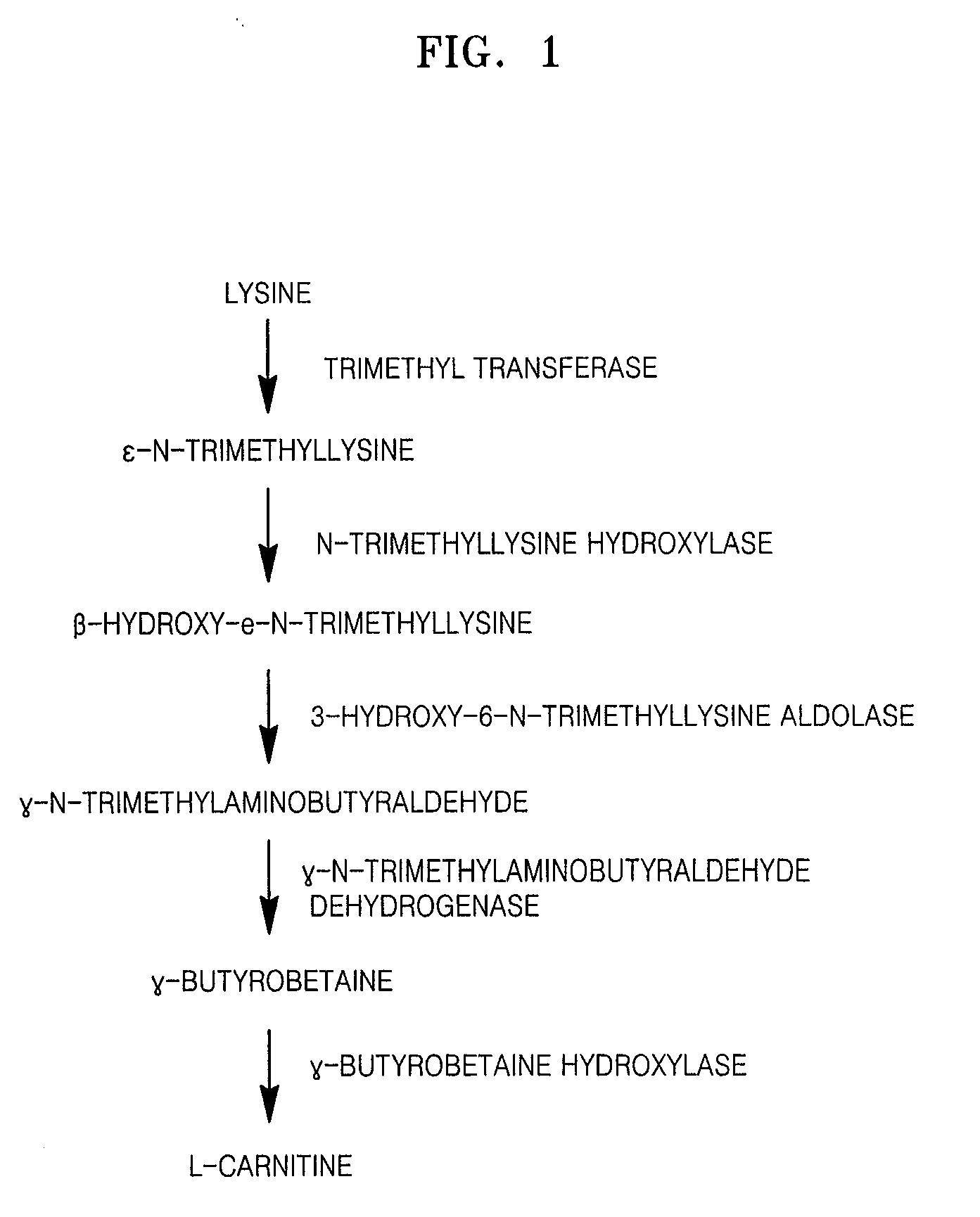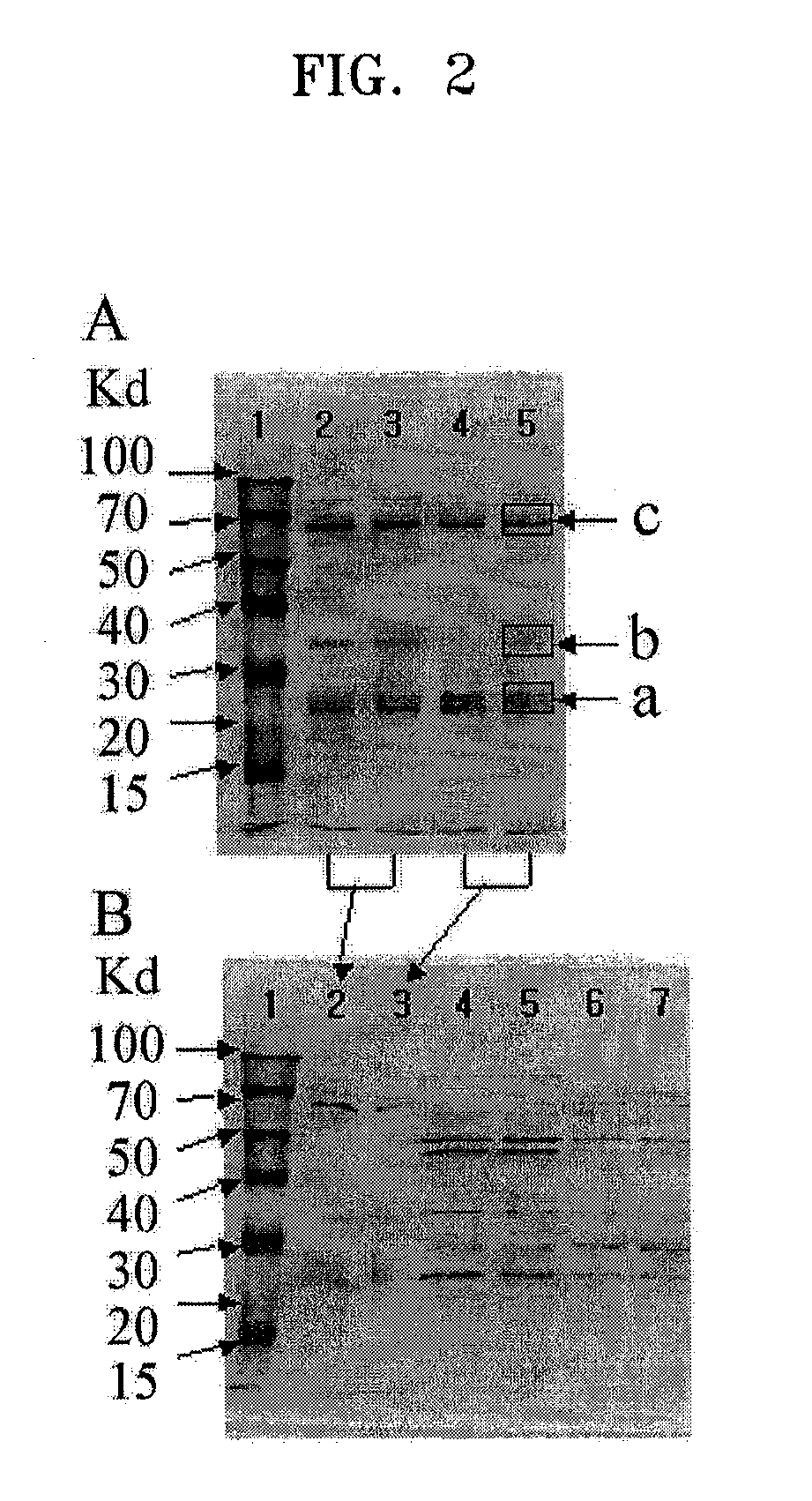Microorganism of Enterobacteriacae Genus Haboring Genes Associated With L-Carnitine Biosynthesis and Method of Producing L-Carnitine Using the Microorganism
a technology of enterobacteriacae and microorganisms, which is applied in the field of microorganisms of enterobacteriacae, can solve the problems of low production efficiency of l-carnitine, low efficiency of l-carnitine production, and unstable dehydrocarnitine, and achieves good ability to produce l-carnitine. high efficiency
- Summary
- Abstract
- Description
- Claims
- Application Information
AI Technical Summary
Benefits of technology
Problems solved by technology
Method used
Image
Examples
example 1
Isolation of Polynucleotide Encoding LMT, TMLH, TMLA, TMABADH and BBH from Neurospora crassa
[0038]Polynucleotide encoding LMT, TMLH, TMLA, TMABADH and BBH from Neurospora crassa was isolated and cloned, and a base sequence thereof was analyzed.
[0039](1) Production of cDNA Library of Neurospora crassa
[0040]The total mRNA was isolated from a culture including fungal body of Neurospora crassa (including a sporophyte) and reverse transcribed using poly T as a primer, and then PCR was performed to amplify cDNA. The amplified cDNA was digested with EcoRI and XhoI, and then the digested cDNA was inserted to a site of EcoRI and XhoI of λAD5 cloning vector to produce cDNA library from Neurospora crassa.
[0041]Next, the cDNA library was infected into E. coli BNN322, and then the infected E. coli BNN322 was cultured and amplified. First, E. coli BNN322 was cultured overnight in a LB medium including 50 μg / ml of kanamycin and 0.2% of maltose. Then, centrifugal separation was performed for the...
example 2
Production of Host Cell Including all of LMT, TMLH, TMLA, TMABADH and BBH Gene
[0086]Genes of LMT, TMLH and BBH from cDNA library of Neurospora crassa that was produced in Example 1 were amplified, and pT7-7 ABE having all of the three genes was produced. In addition, genes of TMLA and TMABADH from cDNA library of Neurospora crassa that was produced in Example 1 were produced, and pACYC184-CarCD having all of the two genes was produced. The produced pT7-7-CarABE and pACYC184-CarCD were employed in E. coli to produce a transformed microorganism having all of the genes of LMT, TMLH, TMLA, TMABADH and BBH. The transformed microorganism was referred to as E. coli BL21 (DE3) CJ2004-2, and deposited on Dec. 13, 2004, in Korean Culture Center of Microorganisms (KCCM), an International Depositary Authority (Accession number KCCM-10638).
[0087](1) Production of pT7-7-CarABE Having all of the Three Genes of LMT, TMLH and BBH
[0088]First, lmt including termination codon was amplified from T7 prom...
example 3
Production of L-Carnitine Using a Microorganism Including Polynucleotide Encoding LMT, TMLH, TMLA, TMABADH and BBH
[0091]E. coli BL21(DE3) in which both pT7-7-CarABE and pACYC184-CarCD produced in Example 2 were introduced was cultured in a medium including L-Iysine, and a production amount of L-carnitine was determined. The introduction of pT7-7-CarABE and pACYC184-CarCD into E. coli BL21(DE3) was performed using electroporation as described in Example 1.
[0092](1) Production of L-Carnitine by Culturing E. coli BL21 (DE3) that was Transformed with Both PT7-7-CarABE and pACYC184-CarCD that were Produced in Example 2
[0093]First, E. coli BL21 (DE3) that was transformed with both pT7-7-CarABE and pACYC184-CarCD was plated in a LB solid plating medium including ampicillin (100 μg / ml) and chloramphenicol (50 μg / ml), and cultured. Colonies of the microorganism in the solid plating medium were incubated to OD600 1.0 at 37° C. for 12 hours in a flask including 20 ml of a LB medium to which am...
PUM
| Property | Measurement | Unit |
|---|---|---|
| pH | aaaaa | aaaaa |
| concentration | aaaaa | aaaaa |
| concentration | aaaaa | aaaaa |
Abstract
Description
Claims
Application Information
 Login to View More
Login to View More - R&D
- Intellectual Property
- Life Sciences
- Materials
- Tech Scout
- Unparalleled Data Quality
- Higher Quality Content
- 60% Fewer Hallucinations
Browse by: Latest US Patents, China's latest patents, Technical Efficacy Thesaurus, Application Domain, Technology Topic, Popular Technical Reports.
© 2025 PatSnap. All rights reserved.Legal|Privacy policy|Modern Slavery Act Transparency Statement|Sitemap|About US| Contact US: help@patsnap.com



